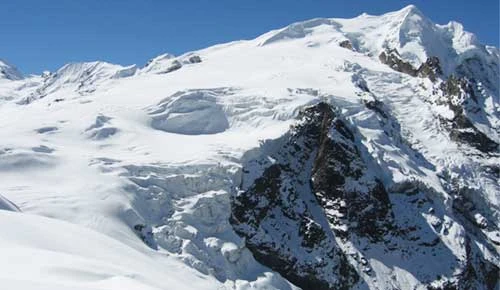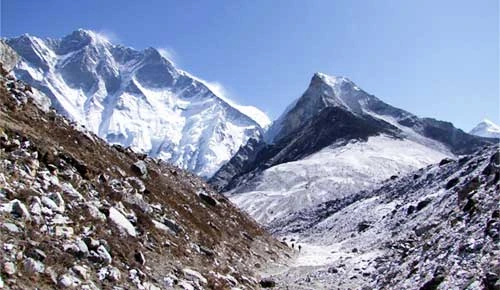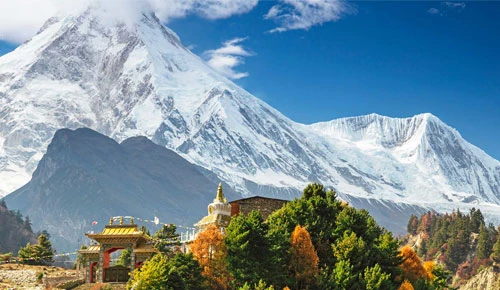Lobuche Peak : The Best Acclimatization Climb for 7000m+ Expeditions
Lobuche Peak, standing at approximately 6,119 meters, is one of Nepal’s most sought-after high-altitude climbs. Located in the Everest region, it provides climbers an exceptional opportunity to experience the thrill of mountaineering while preparing for 7000m+ expeditions. This peak is particularly ideal for trekkers seeking a combination of adventure and practical acclimatization trek, as it allows gradual adjustment to thinner air, extreme weather, and rugged terrain. Climbers can enjoy breathtaking Himalayan vistas while gaining hands-on experience navigating glaciers, rocky ridges, and high-altitude conditions.
Beyond its physical challenges, Lobuche Peak climbing holds strategic importance for mountaineers. Ascending this peak offers essential high-altitude training, helping climbers enhance their stamina, test mountaineering gear, and mentally prepare for more demanding Himalayan summits. By choosing Lobuche Peak, adventurers can experience both Nepal trekking and technical climbing in a controlled yet thrilling environment, making it an indispensable stop for serious 7000m+ expedition preparation.
Location and Overview of Lobuche Peak
Lobuche Peak is strategically located in the heart of the Everest region, near the Khumbu Valley and along key trekking routes leading to Everest Base Camp. Its prime location offers panoramic views of iconic Himalayan giants such as Ama Dablam, Lhotse, and Nuptse, making it one of Nepal’s most visually stunning high-altitude trekking and climbing destinations. With easy access from Lukla, climbers can efficiently reach the starting point while immersing themselves in the rich Himalayan culture and mountain environment.
Rising to 6,119 meters, Lobuche Peak is considered a moderate climb, ideal for adventurers with prior trekking experience and some technical climbing knowledge. The route features glaciers, rocky ridges, and occasional snowfields, providing practical high-altitude training for those preparing for future 7000m+ expeditions. For climbers short on time, the Lobuche Peak Climbing - 3 Days itinerary offers a quick but rewarding ascent.
Meanwhile, the more extensive Lobuche West Peak Climbing and Lobuche East Peak Climbing expeditions provide ample time for acclimatization, trekking through the Khumbu region, and multiple practice climbs, helping climbers build the endurance, mental resilience, and mountaineering skills needed for higher peaks.
Whether opting for the short 3-day climb or the comprehensive 19-day expeditions, Lobuche Peak is an essential acclimatization climb that combines adventure, skill-building, and breathtaking Himalayan scenery.
Table of Contents
Why Lobuche Peak Is Ideal for Acclimatization
Climbing Lobuche Peak is a crucial step in preparing for higher Himalayan summits. It allows climbers to gradually adjust to thinner air and extreme conditions while gaining experience with technical climbing techniques.
Benefits include:
- Gradual exposure to high-altitude conditions, reducing the risk of altitude sickness.
- Practice on glaciers and rocky terrain to build technical climbing skills.
- Experience with snowfields and mixed climbing environments for future 7000m+ peaks.
- Short acclimatization hikes and climbs to improve stamina and cardiovascular endurance.
- Hands-on training with ropes, crampons, and mountaineering gear.
- Mental conditioning for handling extreme weather, early starts, and long climbing days.
- Opportunity to observe and adjust to Everest region weather patterns and mountain conditions.
- Building confidence and familiarity with high-altitude trekking Nepal, which prepares climbers for future expeditions.
Best Time to Climb Lobuche Peak
The best seasons for best Lobuche Peak climbing are spring (March to May) and autumn (September to November). Spring offers blooming rhododendrons, moderate temperatures, and clear skies, making spring climbing Nepal and acclimatization trek exercises both enjoyable and safe. Autumn, in contrast, is known for its stable weather, dry trails, and excellent visibility, ideal for autumn trekking Nepal and high-altitude training.
Weather in the mountain weather Nepal can change rapidly, with potential snowstorms or strong winds. Planning climbs during spring or autumn ensures safety and maximizes the Himalayan experience. Both seasons allow climbers to gradually adjust to high altitudes while enjoying some of the most breathtaking landscapes Nepal has to offer.
Trek & Climb Itinerary for Lobuche Peak : Experiential Approach
Climbing Lobuche Peak is an immersive acclimatization climb adventure for climbers preparing for 7000m+ expeditions. This approach combines trekking, technical climbing, and high-altitude adventure to offer a complete mountaineering experience in the Everest region Nepal.
Section 1: The Pre-Climb Adventure – Kathmandu to Lukla
The journey to Lobuche Peak begins with an unforgettable adventure: the flight from Kathmandu to Lukla. Most climbers choose this short but scenic flight, which offers sweeping panoramic views of the Himalayan range, including towering peaks, deep valleys, and glacial rivers. For those seeking an extra thrill, the alternative Ramechhap to Lukla flight route provides an equally stunning and less crowded aerial perspective of the mountains.
Upon arrival in Lukla, climbers are greeted by a vibrant hub of activity. The bustling markets, quaint tea houses, and lively Sherpa culture provide the perfect environment for mental and physical preparation. Here, climbers can acclimatize gradually, organize gear, and savor local delicacies like momo and dal bhat before stepping into the demanding high-altitude trekking environment. Lukla is more than just a starting point—it’s an introduction to the unique lifestyle, resilience, and warmth of the Himalayan communities.
Section 2: Immersive Himalayan Trekking
From Lukla, the trek to Lobuche Peak weaves through some of Nepal’s most iconic Himalayan landscapes. Namche Bazaar, the bustling Sherpa town, marks the first major stop, where climbers can stock up on supplies and absorb the energetic yet serene mountain atmosphere. Continuing onward, the trail passes through Tengboche, home to the famous Tengboche Monastery, which offers spiritual solace and panoramic views of Ama Dablam, Everest, and Lhotse.
The journey is punctuated with practical acclimatization hikes, which help climbers adjust to the thinning air while strengthening their endurance. Trekkers cross suspension bridges spanning icy rivers, walk through rhododendron forests bursting with spring blossoms, and encounter local villages, providing a deep cultural immersion. Each day of trekking not only builds physical stamina but also offers breathtaking views that reinforce why Nepal remains the ultimate destination for Himalayan trekking.
Section 3: High-Altitude Base Camp Experience
Upon reaching Lobuche Base Camp, climbers enter a world of serious preparation. This high-altitude environment allows for hands-on acclimatization exercises, such as short climbs, rope handling drills, and glacier navigation practice. The base camp serves as both a training ground and a familiarization zone with the harsh conditions climbers will encounter on 7000m+ peaks.
Many expeditions offer optional side-treks to nearby minor peaks. These early summit attempts are invaluable for building confidence, testing gear, and refining techniques like ice axe use, crampon walking, and high-altitude endurance. The experience gained at Lobuche Base Camp directly contributes to a safer and more successful ascent on future high-altitude expeditions.
Section 4: Summit Preparation & Mental Challenge
Summit success relies as much on mental resilience as physical fitness. At Lobuche Peak, climbers dedicate time to gear checks, weather assessments, and short pre-summit climbs, ensuring every step of the final ascent is carefully planned. This phase encourages focus, patience, and strategic thinking—qualities essential for tackling extreme altitudes safely.
High-altitude climbing is as much a mental exercise as it is a physical one. Facing cold winds, reduced oxygen levels, and challenging terrain teaches climbers how to remain calm under pressure and maintain steady pacing. By the time summit day arrives, climbers are not only physically prepared but also mentally equipped to tackle the challenges of peaks above 7000 meters.
Section 5: Summit Day Adventure
Summit day begins in the early hours to witness a breathtaking sunrise over the Khumbu region. The trail involves navigating glaciers, rocky ridges, and snowfields, requiring concentration, endurance, and teamwork. Every step brings climbers closer to the summit, at an elevation of 6,119 meters, where the effort culminates in a panoramic reward: sweeping views of Everest, Lhotse, Nuptse, and Ama Dablam.
Reaching the peak of Lobuche is personal achievement as well as a practical training ground for higher-altitude ascents. Climbers gain firsthand experience of the demands of high-altitude climbing, including managing fatigue, adjusting breathing, and maintaining focus under challenging conditions. The sense of accomplishment instills confidence and motivation for future expeditions to 7000m+ peaks.
Section 6: Post-Summit Descent & Reflection
After the exhilarating summit of Lobuche Peak, climbers begin their descent back to Base Camp and continue their journey toward Lukla. This stage provides a valuable opportunity to reflect on the climb, consolidate acclimatization gains, and savor the stunning Himalayan landscapes one last time.
For those seeking convenience and a spectacular aerial view of the mountains, many climbers opt for a Lobuche to Kathmandu helicopter flight. This not only saves time but also offers a bird’s-eye perspective of the Khumbu region, showcasing Everest, Lhotse, Nuptse, and Ama Dablam in all their grandeur.
Whether trekking back or taking a helicopter, the journey reinforces the lessons learned during the climb—resilience, focus, and confidence at high altitude. The experience leaves climbers with unforgettable memories, preparing them mentally and physically for future 7000m+ expeditions while providing a remarkable conclusion to their Lobuche adventure.
Required Skills and Physical Fitness for Climbing Lobuche Peak
Climbing Lobuche Peak demands a mix of trekking experience, basic mountaineering skills, and good physical fitness. Proper preparation ensures a safer, more enjoyable ascent and helps climbers acclimatize effectively for future 7000m+ expeditions.
- Prior high-altitude trekking experience is recommended.
- Basic knowledge of using crampons, ice axes, and ropes.
- Ability to walk on glaciers, rocky ridges, and snowfields.
- Good cardiovascular endurance and stamina for long trekking days.
- Mental resilience to handle cold, altitude, and challenging terrain.
- Flexibility and balance for navigating uneven and icy surfaces.
- Regular physical training, including hiking, running, or gym workouts before the expedition.
What Climbers Can Expect during Lobuche Peak
Climbing Lobuche Peak offers an unforgettable high-altitude experience, combining adventure, stunning scenery, and practical acclimatization for future 7000m+ expeditions. Climbers can look forward to:
- Spectacular panoramic views of Everest, Lhotse, Ama Dablam, and Nuptse.
- Challenging yet moderate routes featuring glaciers, rocky ridges, and snowfields.
- Opportunities to improve high-altitude trekking and basic mountaineering skills.
- Immersion in the unique Himalayan culture along the Khumbu Valley.
- Short or extended expedition options: Lobuche Peak Climbing 3 Days, Lobuche West Peak and East Peak Climbing.
- A sense of achievement and confidence for future higher-altitude climbs.
Preparation Tips for Lobuche Peak
Successfully climbing Lobuche Peak requires both physical readiness and careful planning. Proper preparation not only ensures safety but also enhances your acclimatization experience and overall enjoyment of the expedition.
- Start a consistent fitness routine focusing on cardio, strength, and endurance.
- Gain prior trekking experience at high altitudes to build stamina.
- Practice basic technical climbing skills, including using crampons and ice axes.
- Pack essential high-altitude gear: warm clothing, insulated boots, gloves, and headwear.
- Stay hydrated and maintain a balanced diet during training and the trek.
- Acclimatize gradually by following recommended ascent schedules.
- Consider climbing with a certified guide for safety and local expertise.
- Prepare mentally for challenging conditions, including cold, wind, and steep terrains.
Safety Considerations for Lobuche Peak Climbing
Climbing Lobuche Peak is an exciting adventure, but safety should always be a top priority. Proper preparation, awareness of altitude risks, and following expert guidance can ensure a safe and successful climb.
- Always climb with certified guides familiar with the Khumbu region.
- Monitor for symptoms of altitude sickness and acclimatize gradually.
- Carry essential safety gear including crampons, harness, and helmet.
- Check weather forecasts and avoid climbing in unstable conditions.
- Maintain proper hydration and nutrition throughout the expedition.
- Be aware of glacier crevasses, loose rocks, and icy ridges.
- Have an emergency evacuation plan and communication options.
Lobuche Peak as a Stepping Stone for Higher Expeditions
Lobuche Peak serves as an essential stepping stone for climbers preparing for higher 7000m+ expeditions in Nepal. Its moderate difficulty and high-altitude environment make it an ideal training ground for adventurers aiming for peaks like Mera Peak, Island Peak, or even more challenging summits. By attempting Lobuche, climbers can test their physical endurance, technical climbing skills, and mental resilience under real high-altitude conditions, without the extreme risks associated with taller mountains.
The climb allows adventurers to experience glaciers, rocky ridges, and snowfields, helping them understand how their body responds to altitude and exertion. This acclimatization experience is invaluable, as it significantly reduces the risk of altitude sickness during future expeditions. For those on a tight schedule, the Lobuche Peak Climbing - 3 Days option offers a short yet effective climb to gauge high-altitude performance. Meanwhile, the longer Lobuche West Peak Climbing - 19 Days or Lobuche East Peak Climbing - 19 Days itineraries provide comprehensive acclimatization, allowing climbers to adapt gradually while gaining confidence and technical experience over multiple trekking and climbing days.
Beyond physical preparation, Lobuche Peak also teaches critical expedition skills such as route finding, rope management, and safe glacier travel. Climbers learn how to manage energy, nutrition, and hydration effectively at high altitudes—skills that directly impact success on higher 7000m+ peaks. Additionally, the exposure to harsh weather conditions, crevasses, and ice slopes builds mental toughness, ensuring climbers are better prepared for the unpredictable nature of Himalayan expeditions.
In essence, Lobuche Peak is more than just a climb; it is a high-altitude classroom that equips adventurers with the knowledge, experience, and confidence required for ambitious Himalayan summits. Its role as a preparatory climb makes it an indispensable part of any serious mountaineer’s journey toward higher peaks.
Conclusion
Lobuche Peak is the perfect acclimatization climb for those preparing for 7000m+ expeditions. Its combination of trekking, technical climbing, and high-altitude training provides an unmatched Himalayan experience. Climbers benefit from gradual acclimatization, summit practice, and immersive exposure to the majestic Everest region, making it a must-do for serious mountaineers.
Whether you are seeking to enhance your Nepal trekking experience, build confidence for future climbs, or simply enjoy breathtaking Himalayan vistas, Lobuche Peak climbing 2025 offers the ultimate preparation and adventure. Plan your climb today to embark on a safe, rewarding, and unforgettable high-altitude adventure Nepal experience.
Join Nepal Trek Adventure and Expedition for an unforgettable Lobuche Peak climbing experience. Perfect for acclimatization and preparing for 7000m+ expeditions, this adventure combines expert guidance, safe high-altitude training, and breathtaking Everest region views. Book your climb today and take the first step toward your ultimate Himalayan journey!








